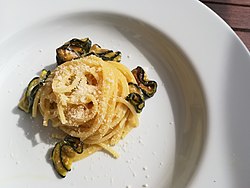 | |
| Course | Primo (Italian course) |
|---|---|
| Place of origin | Italy |
| Region or state | Nerano, Campania |
| Main ingredients | Spaghetti, fried zucchini, provolone del Monaco , Parmesan, extra virgin olive oil, black pepper, garlic, basil |

Spaghetti alla Nerano is a pasta dish invented in the village of Nerano, on the Sorrento Peninsula, made with spaghetti, fried zucchini, provolone del Monaco , Parmesan, extra virgin olive oil, black pepper, garlic, basil, and salt. [1] [2] [3]
Among the many attributions circulating, the main one points to a restaurant owner named Maria Grazia in the mid-1950s. [3] The dish has gained popularity beyond the village of Nerano. [4]